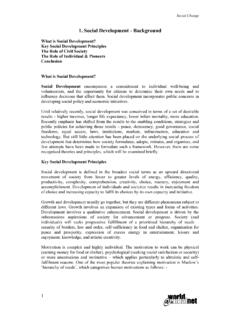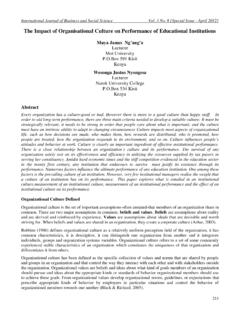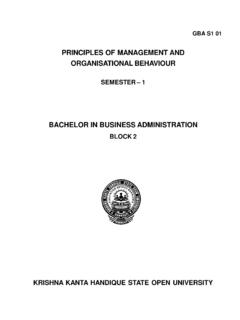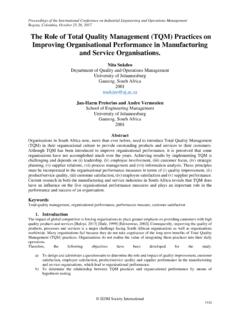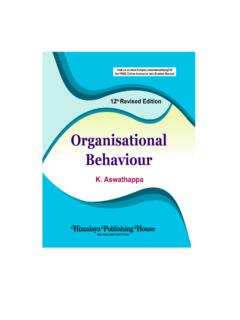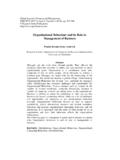Transcription of 2. Strategy, Structure and Organisational Culture
1 Animal Protection Society Management 2. strategy , Structure and Organisational Culture strategy Introduction Definitions The Importance of strategy What Constitutes a strategy ? Vision and Mission Building a strategy The strategy Process Organisational Values Brand Strategic Review Structure & SYSTEMS Introduction Need for Structure Choice of Structure Examples of Structures Approach to Coordination Organisational Culture Introduction Key Cultures Determinants of Culture Changing Cultures FURTHER RESOURCES strategy Introduction strategy is concerned with deciding the nature, domain and scope of an organisation s activities (essentially, what it is like, its values, the areas it covers and the direction it is going in), and the way its success will be evaluated.
2 The pattern of activities in strategy arises from the acquisition, allocation and commitment of a set of resources and capabilities by the organisation, in an effective match with the challenges of its environment, and from the management of the network of relationships with and between stakeholders. Strategic planning is vital to ensure that your organisation follows the most effective course towards its mission. Animal protection societies are bombarded with an increasingly wide and complex set of demands, and can easily become reduced to reactive fire-fighting organisations. This invariable slows down progress towards mission. 1 Animal Protection Society Management Definitions strategy can be defined in many ways, including the following useful examples: - strategy is the pattern of activities to be followed by an organisation in pursuit of its long-term purpose , including its placing within the movement.
3 In simple terms: Where we are now, where we want to go and how we intend to get there . An agreed-upon course of action and direction that helps manage the relationship between an organization and its environment. The goal is to achieve alignment or synergy so that an optimal flow of resources to the institution is achieved. strategy can be defined as the process of identifying, protecting, leveraging and renewing the strategic capabilities of an organisation through its definition of purpose its organisation and processes, and its choice and support of people. What most definitions have in common is: - An understanding/assessment of the organisation s resources and capabilities An understanding/assessment of the external environment From these, a decision on the best way to use and apply the former to achieve an agreed aim in the latter.
4 The Importance of strategy strategy formulation is a vital function of NGO management. A well-focussed and defined strategy is necessary to ensure optimal progress towards mission and vision is achieved - in the same way as a route map (or sea chart) is needed, to ensure the most direct route is taken between home and destination. Also vital are effective ways to monitor, review and realign strategy in the fast-changing animal protection environment. Social goals make it more difficult to determine priorities, set measurable targets and evaluate performance. This does not mean it is impossible, just that it is not easy (or often natural) to do this. Also, there is a marked tendency for the mission driven to consistently broaden their focus and workloads.
5 These factors make it even more important to have a well-defined strategy . What Constitutes a strategy ? strategy can combine some or all of the below factors: - Vision (see below) Mission Statement (see below) Core Values (see below) Goals and Objectives Critical Success Factors what the organisation must get right to succeed in its mission Positioning Similar to brand. Building a valued and preferred position in the minds of your target audience (how you would like them to describe you) Brand/Reputation Developing and communicating powerful and meaningful differences between your offerings and those of your competition 2 Animal Protection Society Management In a middle to large-sized organisation the strategy section would, in reality, probably incorporate several sub-strategies covering key departments campaign strategy , educational strategy , fundraising strategy , financial strategy and IT strategy .
6 Operational planning is agreeing the practical plans to implement the strategy . This is dealt with separately. Strategic Planning Terminology and Hierarchy There is a great deal of inconsistency in how the following terms: strategic issue, goal, and objective, are used. The following is a useful reference/guide that can be applied in the interests of establishing a common vocabulary: Strategic issue A problem or opportunity that the organisation wishes to address or take advantage of. Goal Specific, measurable statements of what will be done to address strategic issues. Objective An activity that will help you accomplish a goal. Objectives, sometimes called tactics, are framed in action plans that detail: Responsibility Timeline Resources Assessment/evaluation Establishing Boundaries In an animal protection organisation context, it is vital that strategy includes boundaries and limits, and aims for focus and prioritisation.
7 The temptation is to include every issue and problem (that might potentially be addressed). However, this is likely to be counterproductive in practice. The underlying objective should be to maximise mission fulfilment, given available resources and this does not mean tackling everything. It means harnessing resources and leveraging these to best effect. Vision and Mission The vision and mission are the starting points of any strategy . We all need a vision of who we are, and what we are aiming for. Then we need to decide what steps we will take to climb towards our ultimate goals. Some animal protection societies have both a mission and a vision, although many have only a mission statement. Briefly, the difference is as follows: - Mission Statement A declaration of an organization s purpose; its raison d' tre.
8 Vision A realistic, credible, attractive future for your organization. The mission is important because it can engage both the hearts ( Culture ) and minds ( strategy ) of the organisation s staff and the board. A good mission that is used well can be inspirational and develop a strong, shared Organisational Culture . It helps to ensure that employees are emotionally tied to the organisation, and that their goals are synchronised with those of the organisation. The vision is a longer-range vision of success and, as such, can be a powerful engine driving an organisation towards excellence. However, for most smaller animal protection societies, a mission alone is probably sufficient. Indeed, it is debatable whether having 3 Animal Protection Society Management both a vision and a mission dilutes and confuses what should be a powerful message of intent (particularly for external audiences).
9 The following guidance on developing a mission has been adapted from HSUS guidance (on its Web Site). The complete version can be found at: Developing a Mission Statement A mission statement sets forth the fundamental purposes for which your organisation has been formed. It should cover: - Purpose why the organisation exists goals and objectives. Programme how you will achieve your purpose Principle what your values are The mission statement should be: - Understandable to the general public Brief short paragraph Realistic in terms of your financial and human resources Specific to provide a framework for your developing objectives and programmes Broad enough to stand the test of time, so it does not need to be reworked frequently Accurate reflection of the boards intent and understanding Operational (state the expected outcome) Building a strategy Building a strategy strategy formulation is a vital function of NGO management.
10 However, strategic management should not be mystified. It is simply developing and advancing the work and concerns of the organisation as a whole, within the constraints and demands of its wider environment. It is often little more than enlightened common sense . Research and analysis are the building blocks of strategy formulation. The key elements needed are an analysis of the organisation s resources and its own particular strengths and an analysis if its operating environment. Thus, you are carrying out both an internal (within the organisation) and external (outside the organisation) analysis. This is necessary to determine the organisation s best fit within its industry ( the role that will help it to achieve most for animals). This is known as effective strategic fit in management terminology meaning a good match between the organisation and its environment.


